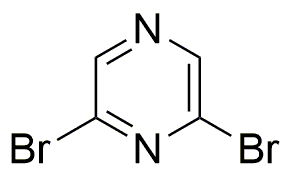2,6-Dibromopyrazine is widely utilized in research focused on:
- Pharmaceutical Development: This compound serves as a key intermediate in the synthesis of various pharmaceuticals, particularly in the creation of anti-cancer and anti-inflammatory agents.
- Agricultural Chemicals: It is used in the formulation of agrochemicals, including fungicides and herbicides, enhancing crop protection and yield.
- Material Science: 2,6-Dibromopyrazine is incorporated into the development of advanced materials, such as polymers and coatings, which exhibit improved thermal and mechanical properties.
- Research Reagents: In laboratories, it acts as a reagent in organic synthesis, facilitating the creation of complex molecules for various research applications.
- Electronics: The compound is explored in the field of electronics for its potential use in organic semiconductors, contributing to the development of more efficient electronic devices.
General Information
Properties
Safety and Regulations
Applications
2,6-Dibromopyrazine is widely utilized in research focused on:
- Pharmaceutical Development: This compound serves as a key intermediate in the synthesis of various pharmaceuticals, particularly in the creation of anti-cancer and anti-inflammatory agents.
- Agricultural Chemicals: It is used in the formulation of agrochemicals, including fungicides and herbicides, enhancing crop protection and yield.
- Material Science: 2,6-Dibromopyrazine is incorporated into the development of advanced materials, such as polymers and coatings, which exhibit improved thermal and mechanical properties.
- Research Reagents: In laboratories, it acts as a reagent in organic synthesis, facilitating the creation of complex molecules for various research applications.
- Electronics: The compound is explored in the field of electronics for its potential use in organic semiconductors, contributing to the development of more efficient electronic devices.
Documents
Safety Data Sheets (SDS)
The SDS provides comprehensive safety information on handling, storage, and disposal of the product.
Product Specification (PS)
The PS provides a comprehensive breakdown of the product’s properties, including chemical composition, physical state, purity, and storage requirements. It also details acceptable quality ranges and the product's intended applications.
Certificates of Analysis (COA)
Search for Certificates of Analysis (COA) by entering the products Lot Number. Lot and Batch Numbers can be found on a product’s label following the words ‘Lot’ or ‘Batch’.
*Catalog Number
*Lot Number
Certificates Of Origin (COO)
This COO confirms the country where the product was manufactured, and also details the materials and components used in it and whether it is derived from natural, synthetic, or other specific sources. This certificate may be required for customs, trade, and regulatory compliance.
*Catalog Number
*Lot Number
Safety Data Sheets (SDS)
The SDS provides comprehensive safety information on handling, storage, and disposal of the product.
DownloadProduct Specification (PS)
The PS provides a comprehensive breakdown of the product’s properties, including chemical composition, physical state, purity, and storage requirements. It also details acceptable quality ranges and the product's intended applications.
DownloadCertificates of Analysis (COA)
Search for Certificates of Analysis (COA) by entering the products Lot Number. Lot and Batch Numbers can be found on a product’s label following the words ‘Lot’ or ‘Batch’.
*Catalog Number
*Lot Number
Certificates Of Origin (COO)
This COO confirms the country where the product was manufactured, and also details the materials and components used in it and whether it is derived from natural, synthetic, or other specific sources. This certificate may be required for customs, trade, and regulatory compliance.


